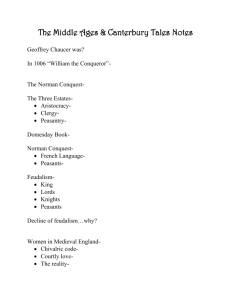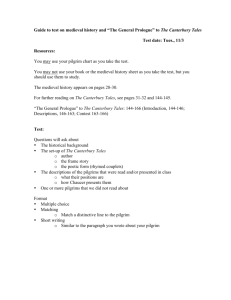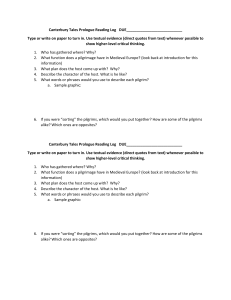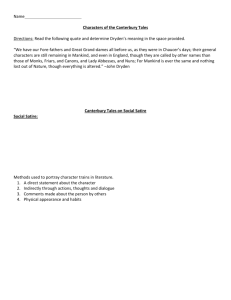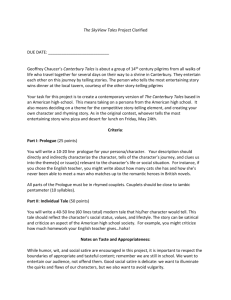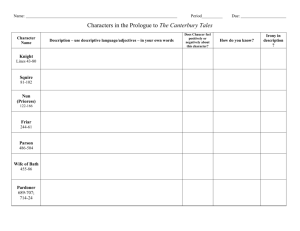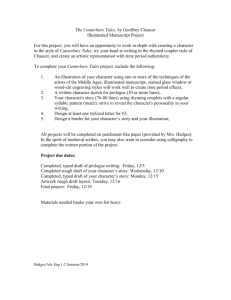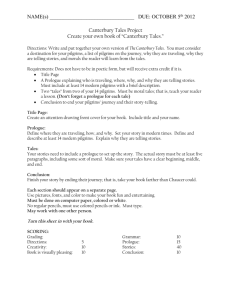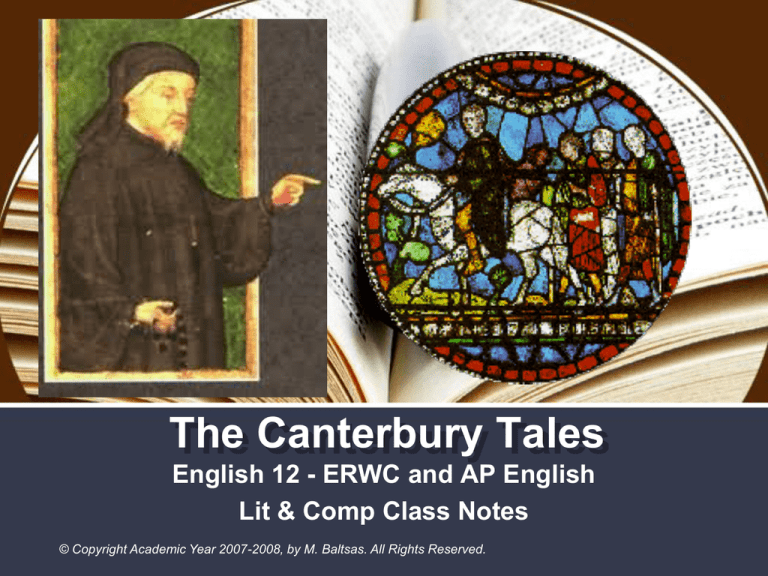
The Canterbury Tales
English 12 - ERWC and AP English
Lit & Comp Class Notes
© Copyright Academic Year 2007-2008, by M. Baltsas. All Rights Reserved.
The Medieval Period – 1200-1450
Period of great change in culture,
politics, science, society, agriculture and
economics.
Urbanization of northern and western
Europe took place
© Copyright Academic Year 2007-2008, by M. Baltsas. All Rights Reserved.
The Seven Deadly Sins
•
•
•
•
•
•
•
gluttony - too much food or drink
ambition - strong desire to get ahead
sloth - laziness
avarice - greed
pride - conceited
wrath - anger
envy - jealousy which leads to hate
Literary Terms
• Allusion - A reference to a historical person, place, or
event that the average reader is unfamiliar with.
• Frame story
– A story is told within a narrative story or frame.
– The frame is introduced in the prologue of the
“Canterbury Tales”
• Characterization
– Development of characters through speech, thoughts,
feelings, actions, appearance
• Genre
– A category that literature is grouped into
• Fiction, mystery, science fiction…
© Copyright Academic Year 2007-2008, by M. Baltsas. All Rights Reserved.
Literary Terms
• Oxymoron
– A statement which brings together two
contradictory terms
• civil war, jumbo shrimp, awfully good
• Satire
– Ideas, customs, and behaviors are ridiculed
for the purpose of improving behavior
• Tone
– The writer’s attitude toward the work
satirical, comical, objective, condescending
© Copyright Academic Year 2007-2008, by M. Baltsas. All Rights Reserved.
Literary Terms – Types of Irony
• Irony
– Contrast between expectation
and reality.
• Sarcasm
– Literal meaning is
complementary, but actual
meaning is critical
• Hyperbole
– Truth is exaggerated for
emphasis or humorous effect
• Understatement
– Creating an emphasis by
saying less than is literally true.
IRONY
© Copyright Academic Year 2007-2008, by M. Baltsas. All Rights Reserved.
Background Information
Point of view
Each of the tales is told from
an omniscient third-person
point of view, providing the
reader with the thoughts as
well as actions of the
characters.
Omniscient – all knowing
Narrator
The primary narrator is an
anonymous member of the
pilgrimage, who is not
described. The other pilgrims
narrate most of the tales.
© Copyright Academic Year 2007-2008, by M. Baltsas. All Rights Reserved.
Background Information
Setting (Time) - The late
fourteenth century, after
1381
Setting (Place) - The Tabard
Inn and the road to
Canterbury
Time and place written
– Around 1386–1395,
England
Author
• Geoffrey Chaucer
© Copyright Academic Year 2007-2008, by M. Baltsas. All Rights Reserved.
Social Class
• Feudal (knighthood)
• Ecclesiastical (church)
• Urban (working class).
© Copyright Academic Year 2007-2008, by M. Baltsas. All Rights Reserved.
Major Conflicts
involve clashes between
social classes
differing tastes
competing professions
conflict between the
sexes
© Copyright Academic Year 2007-2008, by M. Baltsas. All Rights Reserved.
The Prologue
• Prologue - An introduction to the
characters going on the pilgrimage
• Setting - Spring in the city of Southwark
at the Tabard Inn
• 30 pilgrims in all
• 3 groups of pilgrims –
– 1)Oratores (those who pray),
– 2) Bellatores (those who fight), and
– 3) Laborares (those who work)

